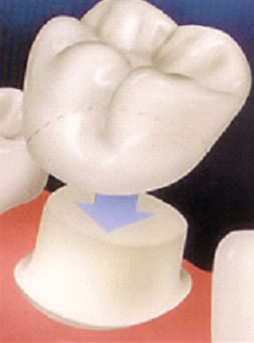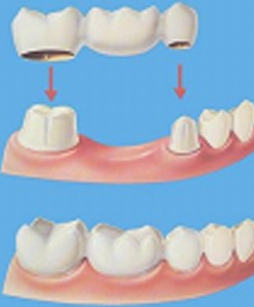A crown (also called a cap) is a man-made cover that protects the top of a tooth. It may be used to restore and preserve a decayed, broken, or cracked tooth. Crowns can also correct some cosmetic tooth problems, giving you a better smile.
- A decayed or damaged tooth that needs to be restored to its normal shape and size.
- A cracked or broken tooth with large cavities or worn fillings.
- A poor-fitting crown.
- A tooth that has a large opening on its top surface after root canal surgery.
- A cosmetic tooth problem.
- A bite problem.
- Before preparing your tooth for a crown, your dentist may first numb the tooth with a local anesthetic. Then, the tooth is filed and shaped, and any decay is scoured from the tooth. A mold is taken of the prepared tooth and the surrounding teeth. A temporary crown is applied to protect the prepared tooth between visits.
- The mold of your teeth is sent to the lab to make your permanent crown. Meanwhile, take good care of your temporary crown by avoiding eating hard or sticky foods; brush gently at the gum line around the temporary crown; carefully floss between your teeth – to remove the floss, pull it out from the side of the tooth, not the top.
- The temporary crown is removed and replaced with the permanent crown. Your Windsor family dentist will fit the crown and makes sure your bite feels normal. Once you both agree the crown fits properly, it is cemented in place.
- Before preparing your tooth for a crown, your dentist may first numb the tooth with a local anesthetic. Then, the tooth is filed and shaped, and any decay is scoured from the tooth. A mold is taken of the prepared tooth and the surrounding teeth. A temporary crown is applied to protect the prepared tooth between visits.
- The mold of your teeth is sent to the lab to make your permanent crown. Meanwhile, take good care of your temporary crown by avoiding eating hard or sticky foods; brush gently at the gum line around the temporary crown; carefully floss between your teeth – to remove the floss, pull it out from the side of the tooth, not the top.
- The temporary crown is removed and replaced with the permanent crown. Your family dentist will fit the crown and makes sure your bite feels normal. Once you both agree the crown fits properly, it is cemented in place.
Living With Your New Crown
Your new crown will help you chew more easily and you may also feel more confident about your smile. Be sure to brush and floss well, and don't forget to see your dentist for regular check-ups as instructed.
Call your dentist if:
- Your teeth become sensitive to hot or cold foods or liquids, or when you bite.
- Your mouth feels painful, or you have a toothache.
- Your temporary or permanent crown becomes loose.
Types of Crowns
A crown is made of gold, other metals, or porcelain. It can also be made of resin, or a combination of porcelain and metal. When choosing a crown, think about how it will look and how long it will last.
- Metal Crown – This crown is made of gold or other metals – this ensures that the crown is very strong and won't break. Because this type isn't tooth-coloured, it may not be the best choice for a front tooth.
- Tooth-coloured Crown – A tooth-coloured crown is made of porcelain or reinforced resin. It comes in a range of shades to blend with your other teeth. This type of crown may be more likely to chip than a metal crown.
- Combination Crown – Porcelain is fused on top of metal, making this crown appear tooth-coloured. The metal at its base makes the crown stronger than a porcelain or resin crown. But it is not as strong as a fully metal crown.
Dental Bridges
A bridge is a way to replace one or more missing teeth. A fixed bridge is one or more replacement teeth attached to the natural teeth next to them which can only be removed by a dentist. Like crowns, a bridge can be made of metal, tooth-coloured porcelain, or a combination of the two. Your family dentist will suggest the best material for your mouth.
Process
- Preparing your teeth – The teeth on either side of the space to be filled must be reshaped which then hold crowns that support the bridge. Impressions of your teeth are the taken which are used to make your bridge. This process takes about two to three weeks. During this time, you may have a temporary bridge to protect your reshaped teeth.
- Fitting your bridge – When your new bridge is ready, your dentist places it on your teeth and adjusts the fit until it feels right. The bridge is then cemented or bonded into place. If there are any problems over the following days, it is important to call your dentist so he or she can advise you what to do or make any other adjustments that may be needed.
Caring for your Bridge
The success of your bridge depends on the level of health of the surrounding teeth and gums. Always clean your bridge and the rest of your mouth carefully, and ask your dentist whether special cleaning aids for bridges would help you maintain your bridge.
- Brushing – Brush after each meal. Brush the surfaces and sides of your bridge like you do your natural teeth. Use an interdental brush to clean between large spaces.
- Flossing – Floss at least once a day to dislodge food and bacteria from between teeth and at the gum line. Special thick floss can help keep your bridge clean, and floss threaders help you floss under a fixed bridge.



